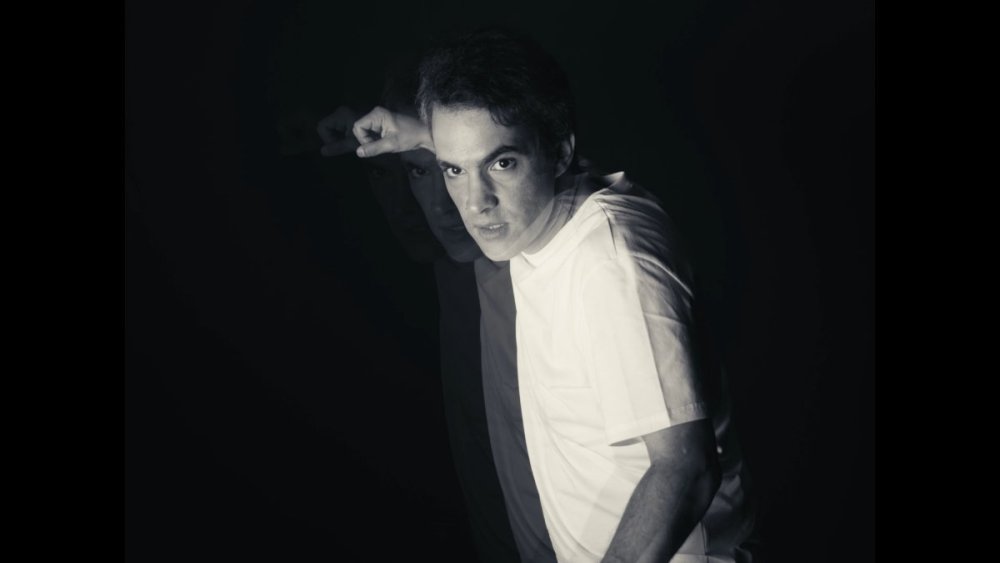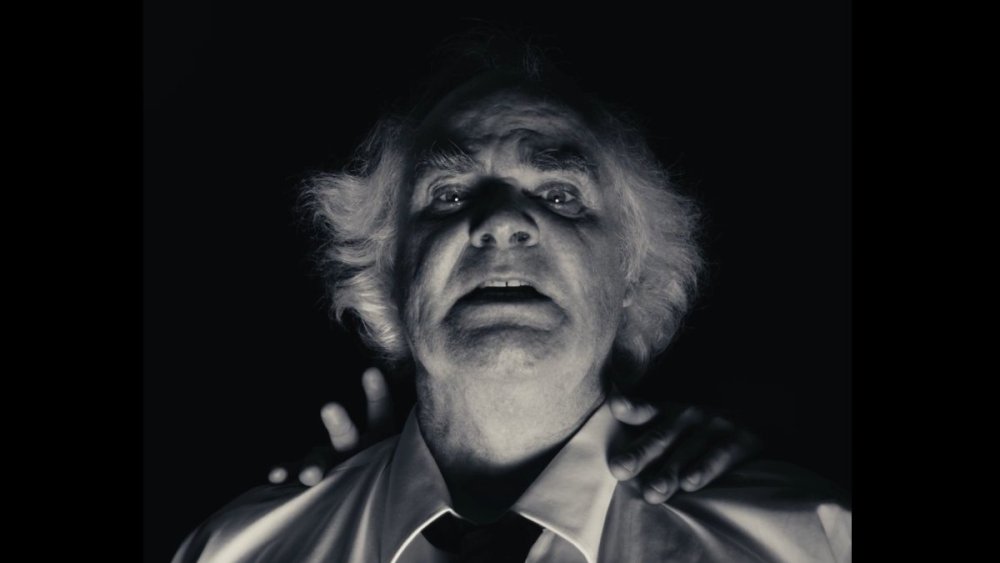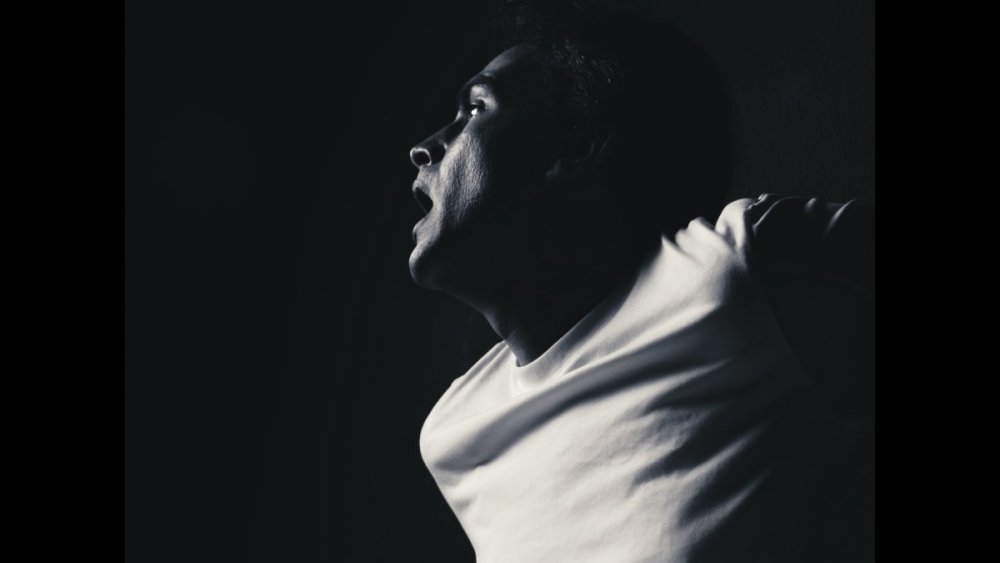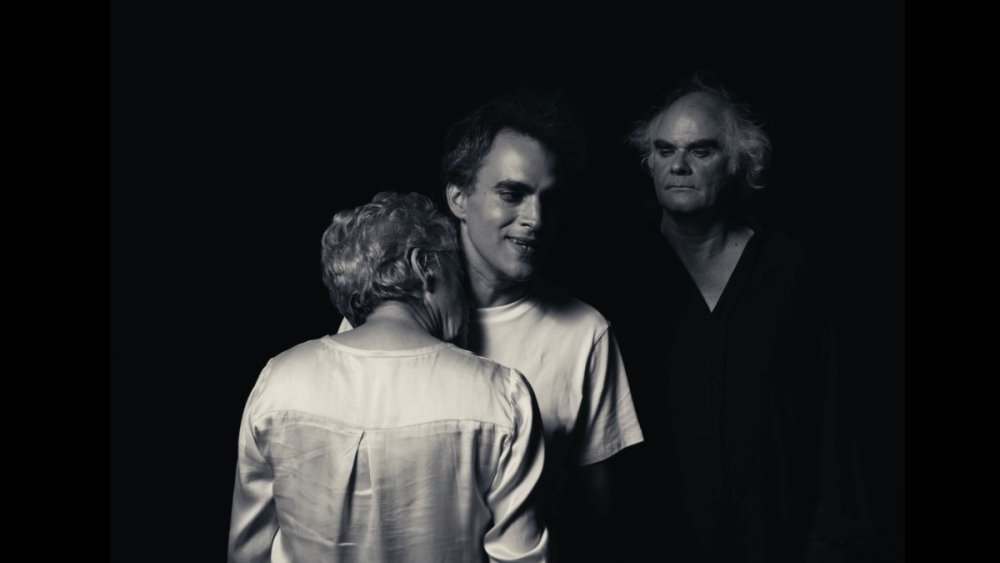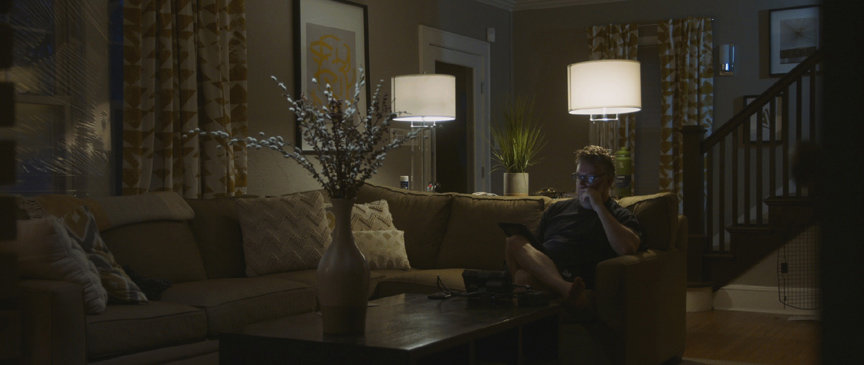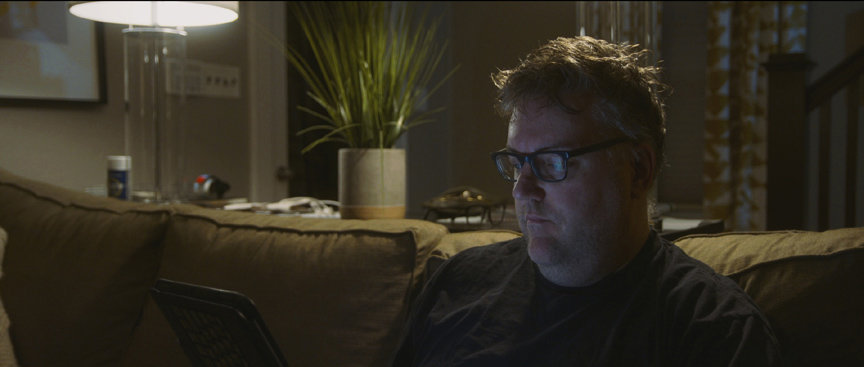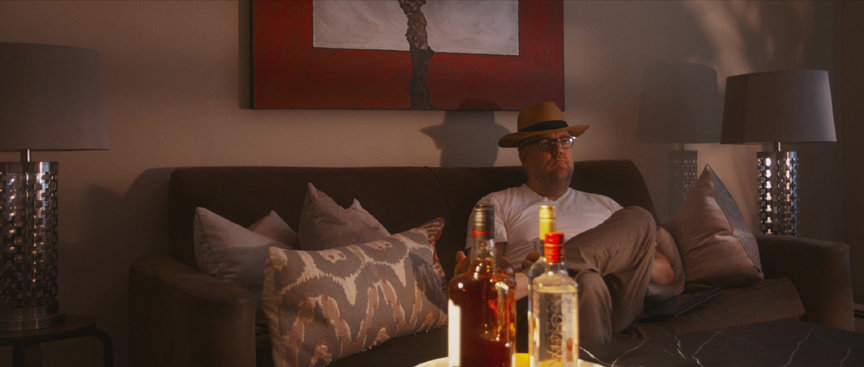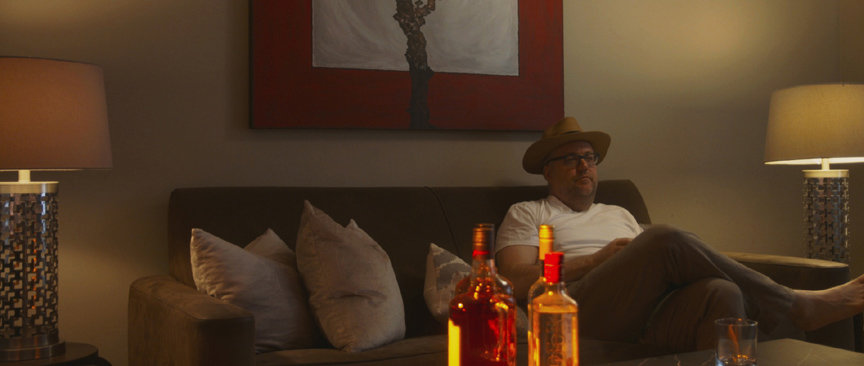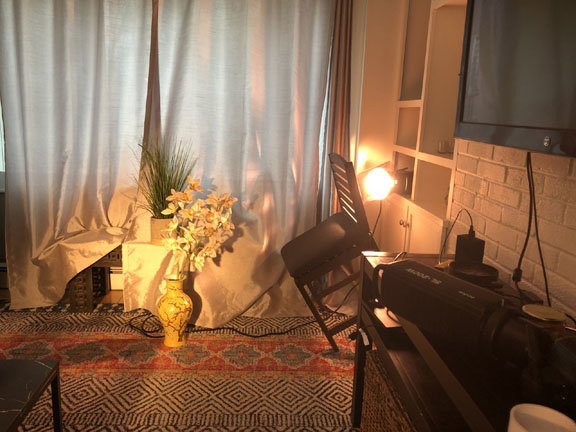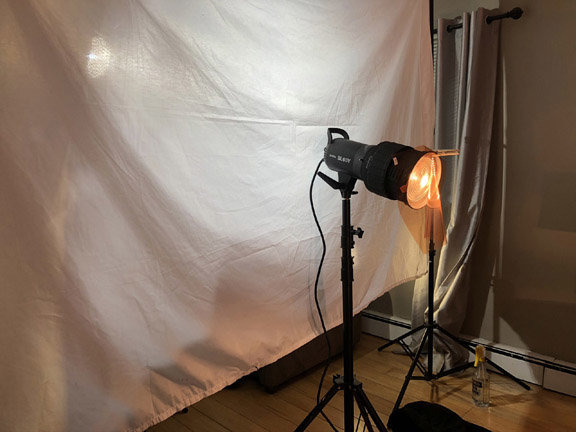-
Posts
37 -
Joined
-
Last visited
Everything posted by Michael Hammond
-
I was recently cinematographer for a really interesting project in Lisbon, Portugal supported by the national council for arts. Essentially it's a contemporary mixed-media take on Hamlet that combines filmed content and contemporary dance. The content I filmed with the team will be projected onto two large screens on a stage. Sometimes the screen will show the same scene, but each side a mirror image of the other. Other times the two screen will have different scenes on them, but those scenes are complementary to each other. The director wanted things to feel claustrophobic and to help achieve that we delivered in 3:4 aspect ratio, did a lot of close-ups of the actors, and crammed multiple actors into a very small space for filming. We also want the audience to feel part of the piece, so often the actors break the 4th wall. Lighting Because the content on screens are Hamlet's memories (murder, madness, betrayal) we also wanted drama, and we needed things outside the scene to drop off into blackness. I proposed a bunch of uplighting and (severe) side light to provide that "ominous" feel, and often used one key light alone with enough light to basically drop the backgrounds into darkness. Top light was used from time to time in scenes where the dialogue was less dramatic. And when actors moved, they moved from one key light to another, passing through darkness in between the lights.
-
- 2
-

-
Hi everyone, Does anyone know of forum boards similar to this one that are geared more towards directors and producers? As a cinematographer I'm looking for online avenues for connecting with people in those positions. I've done some searching and have mostly come up with Reddit subreddits but they don't seem to be for more serious or more professional personas. TIA
-

types of filters and its effects
Michael Hammond replied to Geet Suri's topic in Lenses & Lens Accessories
-
Just saw this film over the weekend and wasn't sure what to expect to be honest. I just knew there was some buzz about the story line and some set design. I was pleasantly surprised and really liked this one. It's kind of a coming-of-age tale but told differently - in a strange parallel world type of setting. Set and art design were creative, the characters were fun and interesting. And the cinematography was different enough to be different without being over-the-top. I think it was used to good effect with fish-eye and wide shots (4mm I've read) being used to tell you how someone was feeling, or that something was about to happen, zooms (digitally done I think) combined with push-ins for a nice effect, etc. B&W mixed with color to set tones and times. From IndieWire - "The cinematographer (Robbie Ryan) sometimes would put a 16mm lens on the 35mm camera which created a vignette effect reminiscent of the dark borders surrounding early photography prints." And "another distinctive lens was a Petzval lens, which are rehoused projector lenses from the early 20th century that create a beautiful portrait look while still having some wide-angle wildness to it." Fun movie with some fun cinematography. Definitely recommend this one.
-
Exactly. It takes a while to realize this I think. I tend to over-complicate things to make sure it's all perfect at times too. But a lot of cinematography is tricks of light anyway. So if I feel I need something (like an eyelight that has no motivation) I'll add one regardless of where the light in the scene is supposed to be coming. As long as it doesn't look completely absurd.
-

International Travel Tips and Tricks
Michael Hammond replied to Brandon Babbit's topic in Camera Assistant / DIT & Gear
You might want to put some hidden AirTags in your more expensive stuff. When I travel anywhere I do this just to be sure. Because, you know. Thankfully I haven't needed to use them yet. -
I find Godox products to be a good budget-friendly alternative to some of the “bigger” names. From my experience their color science has really come a long way and can stand up to the competition. In terms of build, like a lot of things nowadays with plastic bits you need to be careful. But I’ve never personally had a problem with them. Part of my current go-anywhere kit includes 2x Godox SL300. Also consider some GVM RGB panels. Cheaper build quality, but they’re good lights for filling in colors and shadows at a pretty reasonable cost.
-
Hi everyone - would love to connect with any filmmakers in Portugal as I'll be living there for a while in 2022. If anyone wants to meet up to chat and connect let me know. Thanks!
-

Hoping to find a jib that is "good enough"
Michael Hammond replied to Michael Hammond's topic in Camera Operating & Gear
Hi Hanes thx for the suggestion. The issue I’m finding with the products I’m trying is that they’re inherently jiggly due to the construction no matter the kind of camera or weight I use. And they’re also poorly built in a way that as I rotate/pan/crane up and down they go out of level regardless of how level the tripod head is. How do you find the ProAim to be in these situations? -

Hoping to find a jib that is "good enough"
Michael Hammond replied to Michael Hammond's topic in Camera Operating & Gear
Thanks everyone for the suggestions! That intel-a-jib is pretty far out of my budget zone but I make take a closer look at the Seven. I do wish all these companies had better video examples of shots taken with their gear. I find the available examples pretty lacking in professionalism and info. But I've ordered a couple of lower cost jibs to try out...and most likely return. My gut and brain is telling me the ones I've ordered are just not anywhere near good enough. If and when I send them both back I'll dive into the Seven and see about that. -

Hoping to find a jib that is "good enough"
Michael Hammond posted a topic in Camera Operating & Gear
Hi there, I want to buy a jib to upscale my productions. I'm in that spot where I don't want to spend thousands, but I also don't need a top line, ultra-professional piece of gear that I'm going to go into debt for. If I ever need something like that I'll rent. For now, I want something I can set up as a solo shooter or maybe with an assistant. My main "asks" are these: Under $1000 Something I can set up as a solo shooter or maybe with an assistant Doesn't shake or shimmy as it moves (a lot of review videos I watch leave me a little underwhelmed in the stabilization of the shots) Weight capacity of 12lbs or less Does anyone have any experience with a brand that they've use to good effect? I'm looking at CobraCrane for now because it gets good ratings on B&H. Maybe the right jib doesn't exist in my price point? Any input would be very appreciated. Thanks! -

Cinematographer? Fake it till you make it.
Michael Hammond replied to Stephen Sanchez's topic in General Discussion
There's a lot of talk in this thread about technical expertise (or the lack of it) in this new democratized world. How about interpersonal expertise? One of the most important things a great DP needs to know how to do is communicate, interpret and strategize with a director or producer, think quickly on their feet. I wonder what thoughts people have around those things? -

What do you shoot (video/film) for fun, if anything?
Michael Hammond replied to Michael Hammond's topic in General Discussion
My wife is always asking me to film our trips - photos, video, gimbal, drone stuff. Just seems like work when all I want to do is relax, not what I do the rest of the year as a job. -

What do you shoot (video/film) for fun, if anything?
Michael Hammond replied to Michael Hammond's topic in General Discussion
I hear you. After the experimentation phase it does feel like you’re just shooting more of the same. I feel like if I take a (video)camera out of the house it needs to be for something ‘real’ whether it’s a passion project or a job. That being said, with COVID slowing things down I can start getting a little stir crazy. Trains give me something enjoyable to film. Gets me out of the house to somewhere quiet and/or private, and there’s even the thrill of getting it right in one shot since I can’t call “reset” and back a freight train up to a mark. Then there’s hoping to nail it before a cloud comes along. And trying to make each train scene unique in framing and movement. -
COVID has kind of forced me to slow down in my professional shooting of corporate and commercial work. Just like a lot of other people. And totally against my will for sure, but I've actually started taking an interest again in filming freight trains here on the East Coast of the US. Filming trains is something I used to love doing and I actually had a business many years ago of filming them, creating and packaging DVDs for other 'railfans' to watch. Then things got too busy with my 'real' work and I couldn't find time to go out and just sit next to an active line and watch them come and go while reading a book. It's interesting to me to see the differences in how I approach filming them now (2020) as opposed to the time before I started studying cinematography (2006-2010-ish). For starters, I spend a lot more time figuring out framing and panning, planning each shot rather than just setting up a camera and hitting record, my exposure expertise is so much better now (using a meter or false color instead of winging it), shooting with a cinema camera and Zoom as opposed to a handheld and onboard mic, carrying a slider or dolly in and out of the woods to add some dynamism to shots, no zooming in and out vs. always zooming in and out in the old days. For others who work professionally, what do you shoot for fun? Vacation videos, family, short films, flowers, sunrises? How do you approach it? With a DP eye or do you just wing it to relax and have some fun? To make this more fun - no 'photography' answers. Has to be film or video.
-

Overuse/Bad use of haze these days
Michael Hammond replied to Michael Hammond's topic in General Discussion
Uh oh, I didn't mean to rant haha! Just wondered if other people noticed/felt the same way. -
A recent post by Karim G. about the use of underexposure in more modern films, and the ensuing discussion about whether it is planned or just a crutch for some filmmakers, got me thinking about something that's been bothering me for the last 6 months or so and wanted to get others' opinions. Haze has been used for a long time in cinema and it adds dimension, mood, story, etc. Actors walk into an old unused house and there's haze in the air to make it feel old. Actors are in a huge building and there's haze to give a feeling of depth and dimension. It's another tool in the tool box. But does anyone else notice newer content where haze just seems to be thrown into a scene for no reason at all? I mean, sure it looks cool to see light beams in the air, but when the scene takes place in a new house in the middle of the day and no one is smoking and no food is burning in an oven somewhere? I can see a littttttle bit of haze to add a little something-something to a scene but, man, it seems like some shows are going overkill with it. And then there's the use of haze where it hasn't been diffused enough and you can see wisps of it floating around. That works when talent is smoking but not when someone is walking down a flight of stairs to get breakfast on a nice sunny day. Don't mean to rant really, just want to get others' opinions. And I don't have any ready examples. These are just shows and scenes I come across and make a mental "hmmm" but I don't write them down.
-
Just watched this for the first time on Amazon Prime last night. I was struck by some of the framing that was used. In addition to the scene shown by the OP, there is scene that takes place at a dam and the framing really gave me a sense of doom in that you could feel the power and speed of the water as it's release into the river behind the actors. No green screen here - just (I think) a long lens compressing the space between the actors as the cascading waters rush towards them. I enjoy a movie that takes its time with well-developed shots. Something I think is missing a little bit in most blockbusters today.
-

Looking to Improve My Lighting Techniques
Michael Hammond replied to Michael Hammond's topic in Lighting for Film & Video
Thanks Nicolas I'll check that out. And I'll be working on getting some extra light on a face in a wide scene. One question I have has to do with the addition of haze. How do you get a light off set to key a face in a wide shot without the haze giving away that light? I'll be trying to figure that out soon. -

Looking to Improve My Lighting Techniques
Michael Hammond replied to Michael Hammond's topic in Lighting for Film & Video
Absolutely. I was running the art dept, the prop dept, the gaffer dept. as well as acting DOP so those details definitely fell to the side as I paid more attention to the lighting. I did do a version with a lite panel lighting the bottles from above that looked a lot better. The brightness of that light was lower so the eyes weren't drawn to the bottles as much. But in that version I also didn't have a good bit of light on my far side. It's truly been a practice in just moving things and saying "what does that do to the look" with each change. I don't think any of the setups were perfect but they were all a learning moment in and of themselves. Thanks - I'll check that out. -

Looking to Improve My Lighting Techniques
Michael Hammond replied to Michael Hammond's topic in Lighting for Film & Video
Hi Nicolas, Thanks very much for replying. I agree on all your points for sure. Props, wardrobe, setting and set decoration were all just thrown together so I could light a room. In the first series: I'm trying to figure out how to give an edge/top light to make a person "pop" a little more. It's easy to do in interviews, but in this setting I couldn't figure out how to place a light. Maybe it was a limitation of the space, maybe it was a limitation of my experience. But I couldn't mount anything up high, and as you can see the walls were pretty close so I couldn't figure out how to hide any lights on stands to hit me. I'm going to keep working on that. Second series: I'm OK with the practical behind me giving me an edge and the iPad on my face. I agree the color temp could be warmer. But it's the same problem for me here in that I don't know, yet, how to get light on a face that is so deep in a scene. Do I shoot a frensel toward it from outside frame? But then it's a hard light with a nasty hard shadow somewhere in the background of the scene. Do I mount something overhead (although I couldn't do that here in the house)? I need to keep practicing things like that in this low-pressure environment of working in the house during quarantine. -

Looking to Improve My Lighting Techniques
Michael Hammond replied to Michael Hammond's topic in Lighting for Film & Video
The last setup I did was very simple. Two practicals behind me, an iPad to light my face, and a light thrown up at the top of stairs for a little extra something. I would have gelled the stair light but didn't have access to them at the time. Excuse the quarantine hair haha. As an exercise in using practicals, what do you think of this? -

Looking to Improve My Lighting Techniques
Michael Hammond replied to Michael Hammond's topic in Lighting for Film & Video
So here's my "scene" made up of available stuff in the house. I was going for a speak-easy type of thing in the first pic. The cookie pattern splashing on the back wall. The booze bottle with some gelled light hitting them. The bottles are overlit for my tastes. I didn't have access to an ND gel and the spot was turned down as low as possible. Daylight is sneaking in from the right side due to a big window I closed the blinds over, but didn't black out. In the first pic there are hard shadows behind me. I don't think there's a way to get that pattern without the hard shadows because of the space I had to work in? Anyway, I was unhappy with the shadows until I decided to decide that I was going for a partial noir look. Why not? The second pic is more of a loungy type of thing. No hard light on me or the wall. Relying on the practical and a small overhead light panel to light my far side. What do you think? -
Hi everyone. Part of my quarantine time is spent practicing lighting setups right here in my home. In normal times I do corporate stuff so my interview lighting and b-roll acquisition get plenty of exercise. With this down time in the industry I'm taking time to try and get better at narrative settings and lighting wider shots. It's a great opportunity to take the time to learn new things that can only be learned from doing. I'm posting some pics and details about the space I had to work with for them, my assumptions and questions, and would love any feedback. Any constructive criticism is welcome. The space I had available is about 10x18' with an 8' ceiling. The actual "scene" space was about 10x12' - so not a lot of space. First two pics - my spur of the moment cookie, and a 1K behind a bed sheet for ambient light and one of the spots for some booze bottles.



